 Relevancy and Engagement
agclassroom.org/ne/
Relevancy and Engagement
agclassroom.org/ne/
Lesson Plan
Carbon Hoofprints: Cows and Climate Change
Grade Level
Purpose
Students explore the carbon cycle and evaluate the carbon footprint of cattle. Using critical thinking skills, students will use the Claim, Evidence, and Reasoning model to determine the effect of cows’ methane production on the environment and investigate the extent cattle contribute to climate change. Grades 9-12
Estimated Time
Materials Needed
Engage:
Activity 1: What is the Carbon Cycle?
- Carbon Cycle Photos and Captions, 1 copy per class
- Carbon Cycle 3D Video
Activity 2: The Carbon Hoofprint
- A Cow’s Digestive System video
- Ruminant Digestive Model, 1 copy per student
- Interactive science notebooks or 1 sheet of blank paper per student
- Markers, pens, or colored pencils for labeling
Activity 3: Claim, Evidence, and Reasoning
- Carbon Hoofprints: Claim, Evidence, and Reasoning handout, 1 per student
- The Conversation article, digital access or a hard copy for each student
Vocabulary
carbon: the chemical element of atomic number 6, a nonmetal which has two main forms—diamond and graphite
carbon compound: a substance formed from two or more elements chemically united in fixed proportions
carbon cycle: the biogeochemical cycle by which carbon is exchanged among the biosphere, pedosphere, geosphere, hydrosphere, and atmosphere of the Earth
carbon dioxide: a gas consisting of one carbon atom bonded to two oxygen atoms; the byproduct of cellular respiration in animal cells and combustion of organic materials; essential to the process of photosynthesis in plant cells
carbon footprint: a measure of the amount of carbon dioxide released into the atmosphere by a single endeavor or by a company, household, or individual through day-to-day activities over a given period
chemical element: a substance that cannot be broken down into any simpler chemical substances and is made of atoms all of the same type
climate: the prevailing weather conditions in a specific area over a long period of time
climate change: a change in global or regional climate patterns which can include increased temperatures and extreme weather events such as droughts, floods, etc.
enteric fermentation: a digestive process by which carbohydrates are broken down by microorganisms into simple molecules for absorption into the bloodstream of an animal
global warming: a gradual increase in the overall temperature of the Earth's atmosphere generally attributed to the greenhouse effect caused by increased levels of carbon dioxide and other pollutants
greenhouse effect: the trapping of the sun’s warmth in a planet’s lower atmosphere
greenhouse gas: a gas that contributes to the greenhouse effect by absorbing infrared radiation
methane: a colorless, odorless flammable gas which is the main constituent of natural gas
ruminant: an animal that uses a series of stomach compartments and chews its cud in order to digest plant cellulose
upcycle: reuse discarded material in such a way as to create a product of higher quality or value than the original
weather: the state of the atmosphere at a given place and time in regards to heat, dryness, sunshine, wind, rain, etc.
Did You Know?
- Beef production is responsible for about 2% of U.S. greenhouse gas emissions.1
- Almost 90% of what grain-finished beef cattle eat is not in competition with the human food supply. 82% consists of human inedible forages growing on rangeland and grassland, and 7% is human inedible byproducts.2
- If Americans eliminated all animal protein from their diets, they would reduce U.S. greenhouse gas emissions by 2.6%.3
- Grain-finished beef has a lower carbon footprint than grass-finished beef. Cattle that are fed grain produce less methane and reach market weight more quickly, thus using fewer natural resources.4
Background Agricultural Connections
Climate Change
The earth is heated by the sun, and when the sun’s heat reaches earth, greenhouse gases (GHG)—such as carbon dioxide—trap the heat and keep it from returning back into outer space. This process is called the greenhouse effect. Trapping some heat is a good thing because it keeps the planet warm enough for living organisms to inhabit the earth. However, humans are releasing additional carbon dioxide into the atmosphere which traps higher levels of heat causing the Earth’s temperature to rise. The increase in temperature affects our climate, resulting in climate change. Increasing temperatures and global warming affect our weather with more powerful storms, more flooding, heatwaves, and droughts. However, humans can reduce their carbon footprint by utilizing solar and wind power, driving fuel efficient cars, and reducing electricity use. Agriculture—specifically farming equipment, livestock, and soil—is another sector that contributes to greenhouse gas (GHG) emissions in the United States. Farmers and ranchers continue to look for ways to mitigate carbon emissions while still producing food and fiber.
Carbon in the Earth & Atmosphere
Carbon found in the earth and atmosphere is constant, and like all chemical elements, it is neither created nor destroyed. Carbon appears in various forms—either in its purest state (diamonds or graphite) or as a carbon compound. Carbon compounds form the basis of all life on earth and are found in the tissues of all plants and animals. One of the most common carbon compounds is carbon dioxide (CO2). During photosynthesis, plants use the carbon from carbon dioxide to create sugars. Animals then eat plants to receive the energy they need, and when the bodies of animals decompose, they release carbon back into the atmosphere.
Fossil fuels—coal, natural gas, and petroleum—are created from the bodies of plants and animals that died millions of years ago. Fossil fuels contain carbon because they come from once-living organisms. Humans worldwide depend on fossil fuels for many energy needs. The burning of fossil fuels also releases CO2 back into the atmosphere.
The movement of carbon through various forms and places is called the carbon cycle. When carbon is in the atmosphere, it combines with oxygen to become carbon dioxide—a greenhouse gas. The more carbon dioxide and greenhouse gases there are in the air, the warmer the temperatures on land and in the oceans.3
Nearly all human endeavors contribute to greenhouse gas emissions, including commercial and residential, industry, electricity, transportation, and agriculture. 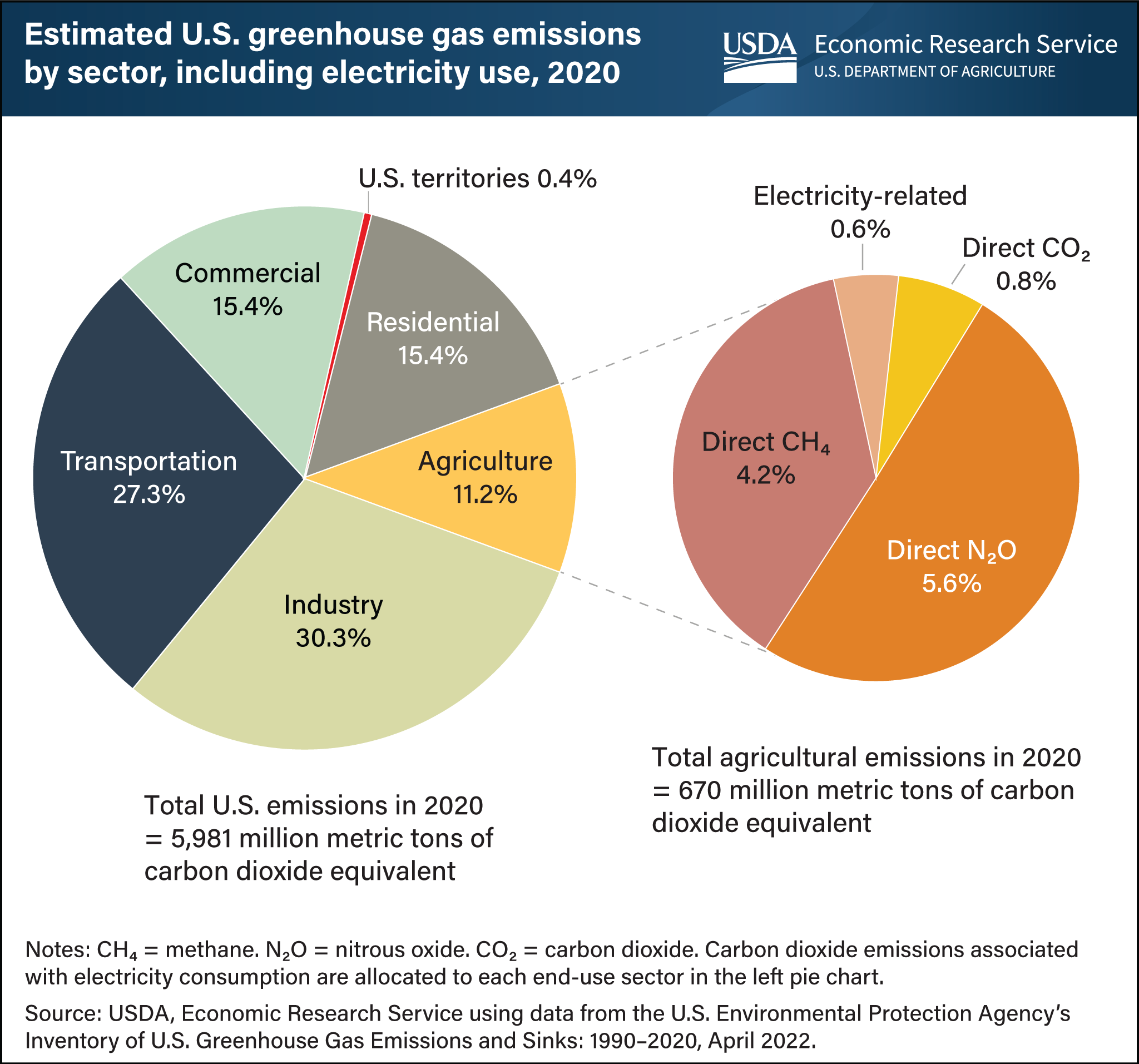
Ruminants and Methane
Methane (CH4) is another common greenhouse gas that is formed when a carbon atom binds with four hydrogen atoms. Methane is the second most abundant global human-caused GHG, behind carbon dioxide. Once emitted, methane has a half-life of about 10 years, while carbon dioxide has a half-life of 1,000 years.13 What many people don’t realize is that livestock-related greenhouse gases are distinctively different from fossil fuel-related gases. To understand the difference between livestock-related gases (methane) and CO2 emissions from fossil fuels, Dr. Frank Mitloehner explains the biogenic carbon cycle that occurs when cattle graze the land: Through the process of photosynthesis, plants use sunlight and water to convert CO2 into carbohydrates. When cattle ingest the grass or feed, some of the carbohydrates (cellulose and starch) are converted into methane in the cow’s rumen. The methane is then released from the cow’s mouth back into the atmosphere. After about 10 years, the methane is converted back into CO2 through hydroxyl oxidation.13 Because of this biogenic carbon cycle, if livestock herds remain constant, or cattle numbers decrease over time, then no additional carbon is being added to the atmosphere. The carbon that is emitted by our livestock is recycled carbon.13
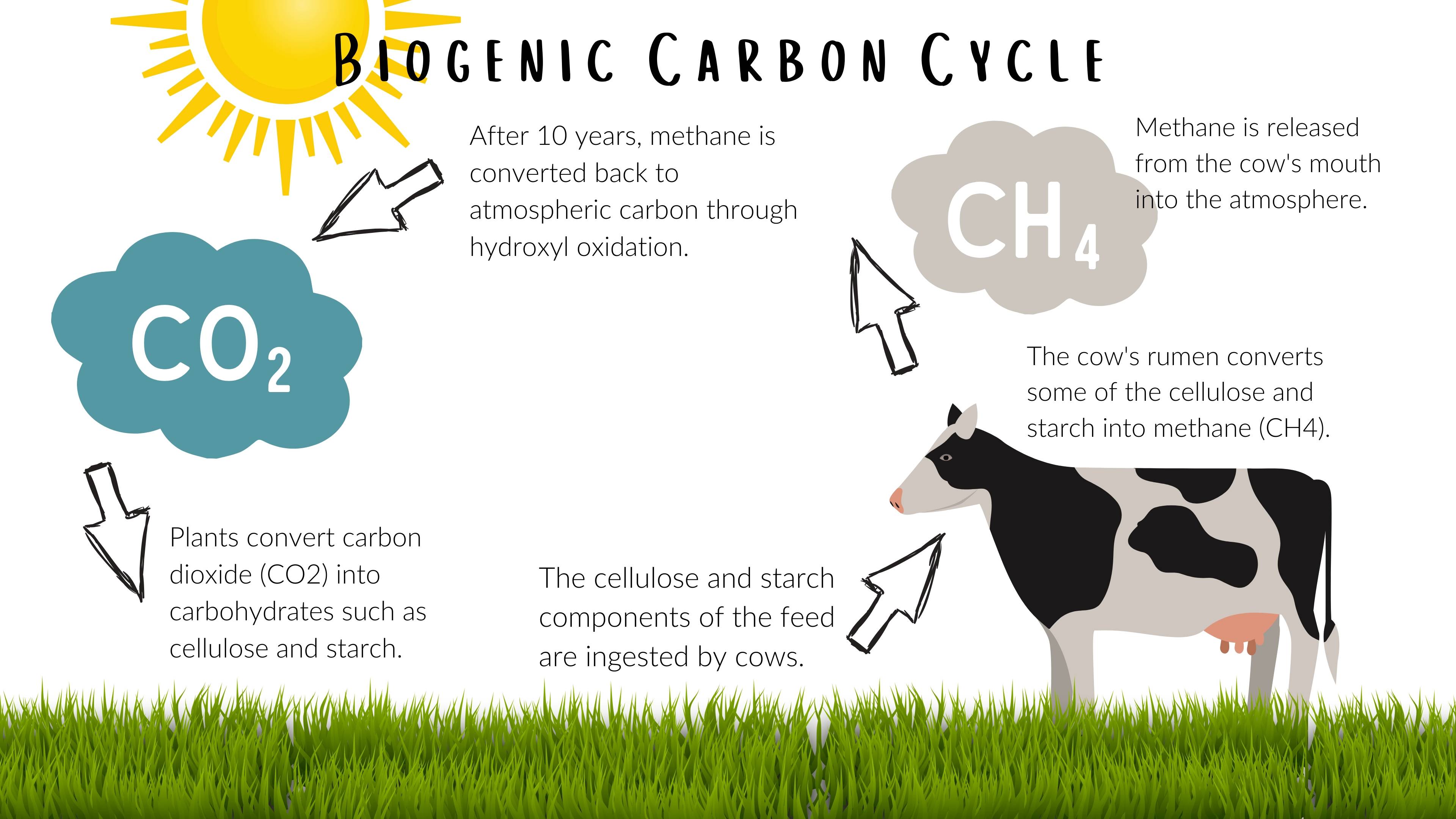
Livestock—especially ruminants—produce methane as part of their normal digestive processes.
Ruminant animals have a unique digestive system that is made up of four stomach compartments: the rumen, reticulum, omasum, and abomasum. During digestion, microbial fermentation occurs in the rumen and breaks down forages into material that can be absorbed and metabolized. This microbial fermentation is also known as enteric fermentation and allows ruminants to digest coarse feeds that non-ruminant animals cannot. When CH4 is produced as a byproduct from microbial fermentation, the methane is then exhaled (burped) by ruminants.
Because of their ruminant digestive system, cows have the unique ability to upcycle human-inedible forages and byproducts. Feeds like hay, grass, cottonseed meal, and distillers’ grain are upcycled into high-quality cuts of protein, iron, and zinc. Cows are not only upcycling products that humans can’t eat, but they’re also grazing in areas that are not suitable for cultivation or building.2 About two thirds of agricultural land is considered "marginal" land because it has poor soil and/or no water, so it is used to graze ruminant animals such as cattle, sheep, or goats. The remaining one third of agricultural land is arable and used for growing crops.4
The Carbon “Hoofprint” of Beef
United States beef has one of the lowest carbon footprints in the world—10 to 50 times lower than some nations.6
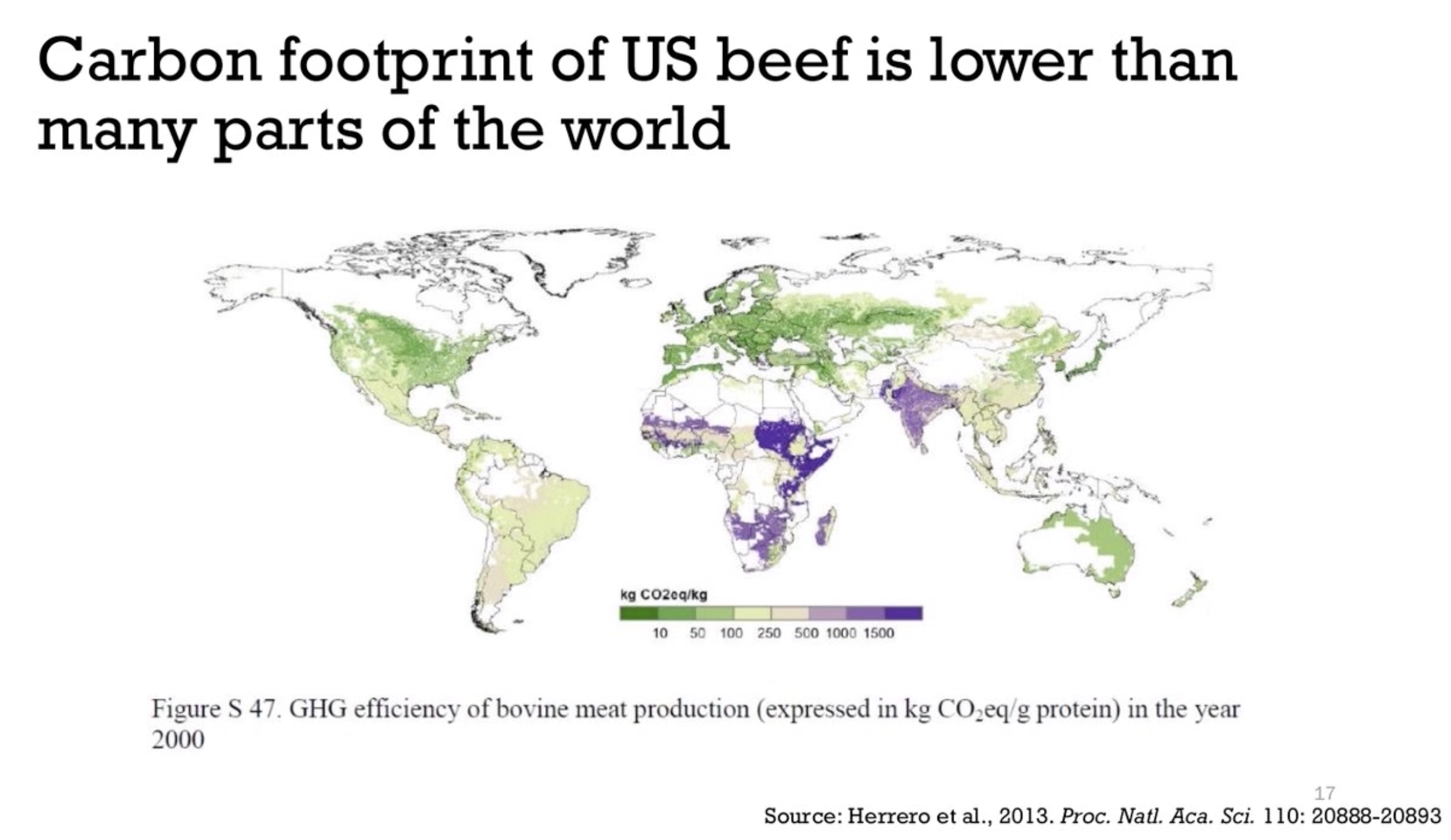
Cows, as ruminants, produce methane. Currently, there are 32 million beef cows in the United States. Greenhouse gas emissions from cattle account for two percent of U.S. greenhouse gas emissions.1 Methane emissions are naturally created by trillions of microbes in the rumen of cattle. One major misconception is that cows release large amounts of methane through flatulence; however, methane emissions from cattle are released when cows exhale or burp. Another common misconception is the belief that cows in feedlots produce more methane than cows eating grass or hay. Scientists have found that diets containing forages and high amounts of fiber cause the microbes in the rumen to produce more methane.4 Cattle that are fed grain produce less methane and reach market weight more quickly, thus using fewer natural resources.4
Recognizing cattle as methane contributors that accelerate climate change, some suggest changes in the diet and lifestyle of humans, such as consuming less beef or no beef at all. Assuming that all livestock in the United States disappeared and every American was vegetarian, greenhouse gas emissions would lower 2.6 percent.1 Students should think critically about the tradeoffs of beef production. Cows are methane producers who contribute to greenhouse gas emissions; however, they’re also excellent at upcycling human inedible forages—grown on marginal land not suited for cultivating crops—into high-quality cuts of meat. Will consuming less beef or eliminating beef altogether slow climate change? Is beef production the highest contributor to greenhouse gas emissions? Placing these scientific questions in context, using science, and looking at the big picture will allow students to answer these important questions.
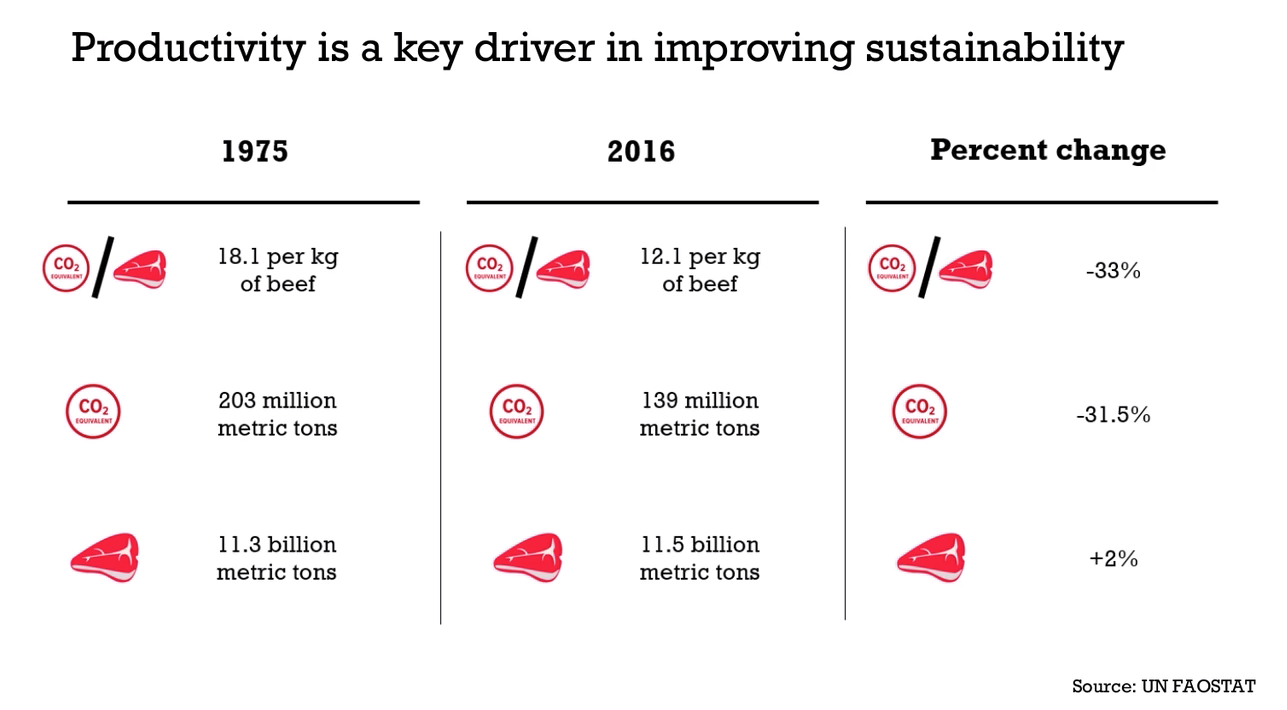
Engage
- Pass out each of the six Carbon Hoofprint Matching Cards to students in the class, or hang the photos on the board in no particular order.
- Ask students to study the pictures. Explain that each picture has a match. Using the photos as clues, have students use their background knowledge to pair each of the cards and explain their reasoning for why the images match.
- Allow students time to brainstorm thoughts and ideas as they match each of the cards.
- Once students have correctly matched each of the photos, discuss key concepts of each photo and its corresponding card. Use the following questions to guide your discussion:
- "Why does the diamond belong with the Periodic Table of Elements?" (Diamonds are the solid form of the element carbon. Carbon is a chemical element that naturally cycles through the earth and atmosphere.)
- "What kind of digestive system do cows, sheep, and goats have?" (Ruminant digestive systems. The stomach of a ruminant has four compartments. Animals with ruminant digestive systems produce methane as they eat and digest forages.)
- "What is the common name for CH4?" (Methane) "What is depicted in the photo with the earth and sun?" (The carbon cycle. Methane, a chemical compound of carbon, is a greenhouse gas that traps heat in the Earth's atmosphere.)
- Explain to students that they will be exploring the relationship between carbon, methane, and ruminants.

Explore and Explain
Activity 1: What is the Carbon Cycle?
- Divide students into pairs.
- Prior to class, print one copy of the Carbon Cycle Photos and Captions and cut the images and word strips into separate pieces. Pass out one hexagonal photo or caption to each pair of students. There are 14 photos and eight captions (22 total), so some pairs might get more than one photo or caption depending on the class size.
- Instruct students to create a carbon cycle diagram as a class by placing the photos and captions on the board and drawing arrows between photos and captions. The class may work together to assemble the cycle. Students may also use markers to draw more illustrations or add more captions.
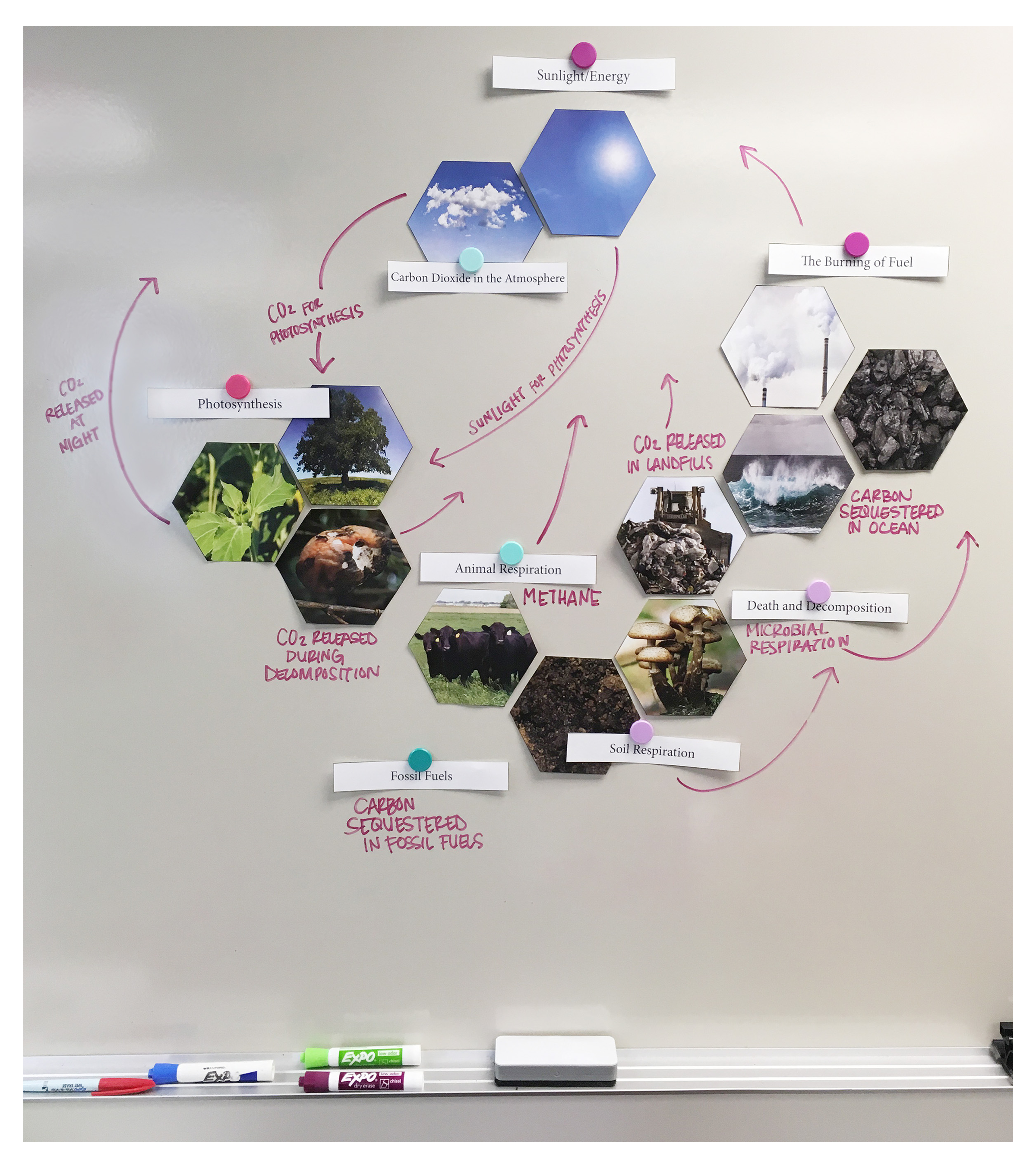
- Engage all students by asking questions about the carbon cycle.
- Why did your group place this photo here?
- How does this photo relate to carbon?
- Show the video clip Carbon Cycle 3D Video to students. If necessary, occasionally pause the video clip and allow students to make changes to their original cycle on the board. They may need to rearrange photos or add more captions.
- Explain to students that the amount of carbon on Earth is constant and is like any other chemical element—it is neither created nor destroyed. Carbon is continuously cycled throughout carbon reservoirs such as the earth, atmosphere, ocean, and living organisms. Carbon atoms then combine with other atoms to create greenhouse gases like carbon dioxide and methane. Greenhouse gases trap the sun’s heat in the Earth’s atmosphere which contributes to climate change.
- Bring students’ attention to the cows on the carbon cycle.
- Ask students how cows contribute to the carbon cycle.
- Allow students to brainstorm thoughts and ideas.
Activity 2: The Carbon Hoofprint
- Remind students that cows are ruminant animals, and ruminant animals—including bison, elk, sheep, and goats—all produce methane. Ruminants are able to eat forages that humans and monogastric (single stomach) animals can’t digest.
- Pass out a Ruminant Digestive Model to each student and ask students to insert the models in their interactive science notebooks so the Ruminant Digestive Model can flip up.
- Tip: If you don't use interactive notebooks, give each student a blank sheet of paper to complete the same activity as an interactive activity sheet rather than in a notebook.
- Show the video clip A Cow’s Digestive System, and have students follow along on their ruminant digestive models.
- Ask students to color each of the labeled compartments, fill in information on feed digestion, and draw arrows depicting how feed travels through a ruminant system. Supplement information from the video clip with the information below and from the Background Agricultural Connection paragraph.
- Rumen: The “fermentation chamber." Food can’t be digested when it first gets to the rumen, so cows regurgitate boluses of food and chew cud. Once the cud has been swallowed, the microbes can now penetrate the cell wall and begin microbial fermentation.
- Reticulum: The “honeycomb stomach.” Catches dense feed or heavy objects (nails, wire, rocks) that the cow may accidentally swallow.
- Omasum: This compartment contains many folds like pages in a book which increases surface area and helps absorb all of the water.
- Abomasum: The “true stomach.” This compartment digests the feed like a monogastric system. Hydrochloric acid and digestive enzymes are released.
- Ask students to brainstorm how this ruminant system produces methane. What compartment produces the methane?
- Using the Background Agricultural Connection paragraph, explain to students how the microbes in a ruminant digestive system produce CH4 (methane) as a byproduct when forages and feeds are digested. Explain to students that it is a common misconception to believe that cow flatulence causes the release of methane into the atmosphere; however, the majority of methane is actually found in a cow’s mouth. Ask students to brainstorm cow burps and the environment. Ask, "How could cow burps be the "culprits" of climate change? If we eliminated all beef cattle, would that slow climate change?"
- Ask students to add the following key terms to the rumen section on their digestive models: microbial fermentation, enteric fermentation, CH4, and methane production.
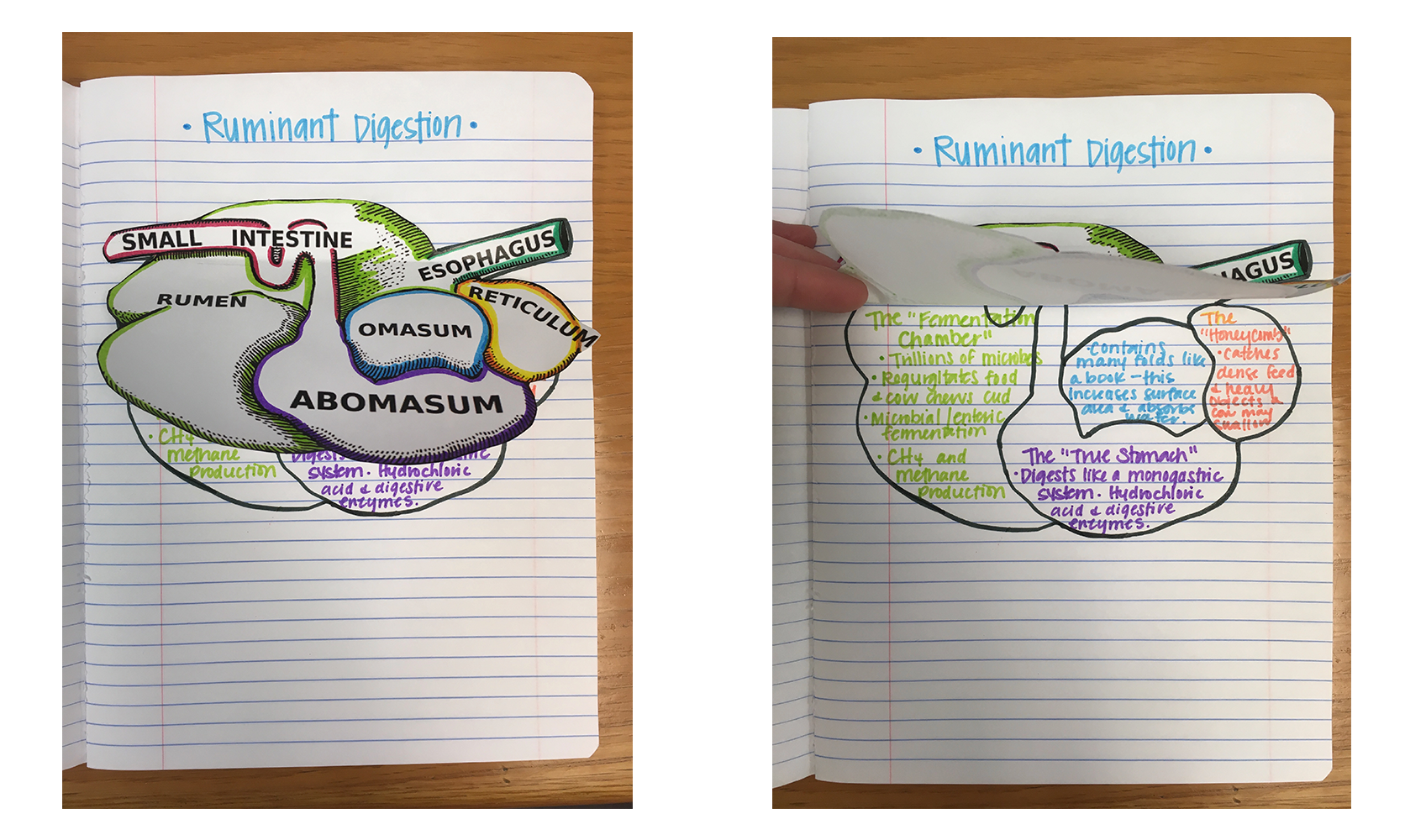
Activity 3: Claim, Evidence, and Reasoning
- Ask students what other questions come to mind after discussing the carbon cycle, methane, and cows. Allow students to brainstorm thoughts and ideas with each other. Examples include:
- If humans stop eating beef, will this slow climate change?
- Are cows the biggest contributors to climate change?
- What other factors contribute to climate change?
- How can humans help lower carbon emissions?
- Give each student one copy of the Carbon Hoofprints: Claim, Evidence, and Reasoning handout.
- Introduce the Claim, Evidence, and Reasoning Model. Explain that after a question is asked, this model can be used to find a credible answer to a question by using the following steps:
- Claim: State a direct response to the question.
- Evidence: Find reliable information that supports the claim.
- Reasoning: Link the claim to evidence by explaining how the evidence supports the claim.
- Instruct students to complete two of the four steps. They should choose one question they would like to answer about the carbon cycle, cows, or methane production. Next, they will formulate a claim by answering their question. Let students know we will come back to the evidence and reasoning portions momentarily.
- Have students turn to the backside of their handout. Let students know that they will be gathering evidence by reading a study published by Professor Frank M. Mitloehner at the University of California, Davis.
- Instruct students to individually read the article from The Conversation and fill out the graphic organizer as they read. Students should answer each of the questions on the back page of their handout. These questions each address common misconceptions about cows and climate change.
- Ask students to write down or highlight words they might not understand. Take time to explain unfamiliar words in the article such as "panacea".
- Discuss science-based responses to each of the statements found on the graphic organizer.
- "Cattle produce more greenhouse gases than the transportation sector."
- False. In 2016, transportation accounted for 28 percent of greenhouse gas emissions. All of animal agriculture contributes about 3.9 percent of GHG emissions in the United States. Some misconceptions stemmed from a 2009 analysis that measured food and animal emissions differently than the transportation sector creating a skewed result.
- "Cattle have negative impacts on the environment."
- Cattle do contribute to greenhouse gas emissions, creating a negative impact on the environment. However, in context, their impact is less than many other contributing factors such as transportation, industry, etc.
- "Participating in 'Meatless Mondays' will make a big impact to help save our planet."
- If all Americans adopted the practice of 'Meatless Monday', we'd see a reduction of 0.5 percent in greenhouse gas emissions, a small amount when considering the full picture.
- "Feeding cattle to produce meat is a waste of resources. We should be growing food for humans instead."
- As ruminants, cattle can receive nutrition from plants that humans and other monogastric animals cannot. Cattle convert plants with no nutritional value (to humans) to food of high nutritional value (meat and milk).
- "It's easy to eliminate meat from our diet and still receive adequate nutrition from other foods."
- Meat provides many essential micro- and macronutrients for good health. While it could be possible to receive these from other foods in developed nations, it is much more difficult in developing nations.
- "Cattle produce more greenhouse gases than the transportation sector."
- Once students have completed the graphic organizer on page 2 of the handout, instruct them to return to the first page of the handout and fill out the "Evidence" and "Reasoning" sections to complete the handout.
- After completing the activity, students should recognize that beef production and eating meat both affect the environment; however, these sectors are not the leading contributors to climate change as some might believe.
Elaborate
-
Discuss the dietary trend to choose beef labeled as "grass-fed" in context of the environment. Introduce the concept to students that different agricultural practices (i.e. how cattle are fed) have varying impacts on the environment. To learn more about "grass-fed" vs. "grain-finished" beef, see Activity 2 of the lesson Beef: Making the Grade.
- Note: Listen to the podcast (#099: Frank Mitloehner: Cattle, Climate Change and the Methane Myth) for an explanation of why grass-finished beef has a larger carbon footprint than grain-finished beef. The concept is addressed at 6:07.
-
To dig deeper into the science and chemistry concepts of climate change and cattle production, listen to the AgFuture podcast, #099: Frank Mitloehner: Cattle, Climate Change and the Methane Myth. In this podcast Dr. Mitloehner explains in greater depth the difference between carbon and methane output in cattle and how the overall efficiency of agricultural systems can reduce greenhouse gas emissions.
-
For an additional or alternative approach to teaching the carbon cycle, see Activity 2 in the lesson Climate Change Phenomena: Bananas in Our Breadbasket
-
Have students read the Climate Change Phenomena e-Magazine to learn more about how climate change impacts other sources of our food supply.
-
Watch videos in the Cows and Climate playlist. These short videos by Dr. Frank Mitloehner, professor at UC Davis, explain answers to common questions about carbon emissions, agriculture, food waste, and sustainability.
Evaluate
After conducting these activities, review and summarize the following key concepts:
- Carbon is a chemical element found in the atmosphere that is neither created nor destroyed.
- Changes in global or regional climate patterns is known as climate change. It is attributed largely to the increased levels of atmospheric carbon dioxide produced by the use of fossil fuels.
- Some perceive cattle to be a major contributor to climate change due to the methane produced in ruminant digestion. However, beef production is estimated to contribute to about 2% of total greenhouse gas emissions in the United States.
Sources
- https://caes.ucdavis.edu/news/articles/2016/04/livestock-and-climate-change-facts-and-fiction
- https://www.animalhealthmedia.com/wp-content/uploads/2018/03/Addressing-the-2050-food.pdf
- https://theconversation.com/yes-eating-meat-affects-the-environment-but-cows-are-not-killing-the-climate-94968
- https://castbox.fm/episode/099%3A-Frank-Mitloehner%3A-Cattle%2C-climate-change-and-the-methane-myth-id1016351-id166145089?country=us
- https://www.youtube.com/watch?v=tfV0XwJSLrI
- http://pods.dasnr.okstate.edu/docushare/dsweb/Get/Document-10191/ANSI-3293.pdf
- https://www.dirt-to-dinner.com/grass-or-grain-beef-is-beef/
- https://kidsgardening.org/garden-how-to-carbon-cycle-and-carbon-sequestration/?utm_source=KidsGardening+Friends&utm_campaign=83eb3dba50-EMAIL_CAMPAIGN_2019_05_01_09_25&utm_medium=email&utm_term=0_0a82c9a42d-83eb3dba50-366559713&mc_cid=83eb3dba50&mc_eid=b1977826f2
- https://www.epa.gov/sites/production/files/2019-04/documents/us-ghg-inventory-2019-main-text.pdf
- https://extension.umn.edu/dairy-nutrition/ruminant-digestive-system#stomach-compartments-1000460
- https://learningstore.uwex.edu/Assets/pdfs/A4131-01.pdf
- https://www3.epa.gov/climatechange//kids/index.html
- https://www.youtube.com/watch?v=PR7ATkTXSb8&list=PLJEeYejb4pU_hRlOxpkNJ1EWELOAgIIeC
Recommended Companion Resources
- An Unusual Snack for Cows, a Powerful Fix for Climate
- Climate Change Phenomena e-Magazine
- Climate Change: The Water Paradigm
- Cows and Climate
- Crash Course Geography
- How to Feed the World in 2050: Actions in a Changing Climate Video
- On the Flip Side Cards
- Our Beautiful Planet: The Climate Secrets of Cows
- Some Like it Hot: Climate Change and Agricultural Pests
- TedTalk- How to Fight Desertification and Reverse Climate Change
- Two Truths and a Lie
- What is Regenerative Agriculture?
- What is Sustainable Agriculture?